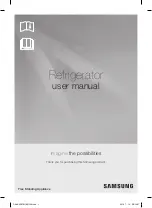
7 Storing food
7.4
Freezing food
Packaging
▸ Store food in the freezer compartment in suitable packaging. Depending on the
product, this may be freezer bags, aluminium foil or plastic boxes. Pack the food as
airtight as possible to prevent freezer burn.
Freezing fresh food
▸ Use the area above the rack in the freezer compartment for freezing food. If there is
frozen food already in the top drawer, distribute it below the rack. Observe the max-
imum freezing capacity (see the identification plate or product fiche).
▸ Activate the fast cooling/freezing functions before loading food or food items into the
appliance (e.g. before going shopping).
▸ There is a risk that freezing fresh food could cause food that is already frozen to par-
tially thaw. Freeze smaller quantities and avoid contact with food that has already
been frozen.
▸ Blanch vegetables before freezing. Aubergines, sweet peppers, courgettes, mush-
rooms, asparagus and herbs do not have to be blanched.
Unsuitable food and products
▸ The following products are not suitable for freezing: radishes, lettuces, cucumbers,
raw unshelled eggs, boiled eggs, dairy products such as yogurt, cream cheese and
curd cheese, and mayonnaise.
7.5
Defrosting food
▸ Do not defrost frozen food at room temperature or on the heating. Food defrosts
slowly in the refrigerator compartment. As a quick alternative, defrost in a microwave
or steamer.
▸ Do not refreeze food once defrosted! Only after being prepared (through cooking or
frying) can food be refrozen.
16













































